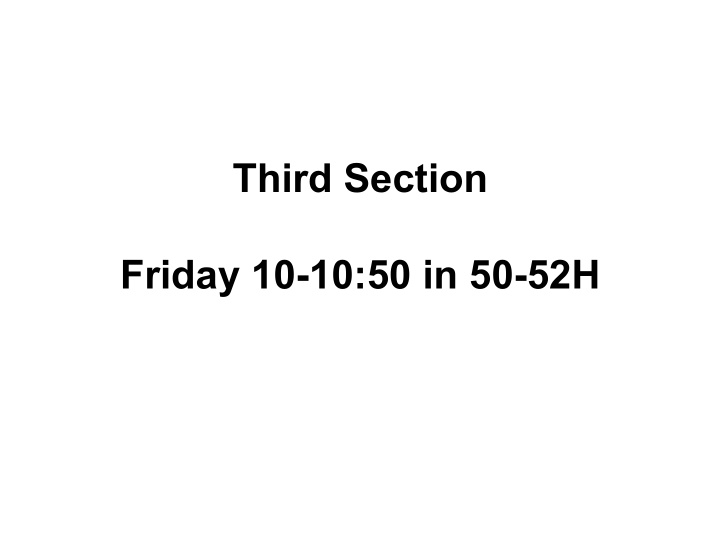



Third Section Friday 10-10:50 in 50-52H
Zulu South Africa: Niger-Congo. ~9,000,000 speakers. 1. ɓɔ na 'see’ 13. i ɓ oni 'grasshopper' 2. ɓɔ pha 'bind' 14. umondli 'guardian' 3. m ɔ sa 'despoil' 15. umosi 'one who roasts' 4. um ɔ na 'jealousy’ 16. inoni 'fat' 5. im ɔ t ɔ 'car' 17. udoli 'doll' 6. iq ɔ l ɔ 'small of back’ 18. umxoxi 'story-teller' 7. ix ɔ x ɔ 'frog' 19. imomfu 'jersey cow' 8. isic ɔ c ɔ 'head ring’ 20. lolu 'this' 9. isith ɔ mbe 'picture' 21. isitofu 'stove' 10. ind ɔ dana 'son' 22. nomuthi 'and the tree' 11. umf ɔ kazi 'strange man’ 23. udodile 'you acted like a man' 12. ibokisi 'box' What is the distribution of [o] and [ ɔ ]? [ ɓ ] is a voiced bilabial implosive stop. [c q x] are dental, alveolar and palatal clicks respectively.
Gascon Southwestern France: Indo-European. ~200,000 speakers balo ‘ball’ dunda ‘to train’ la β a ‘to wash’ a gr a ð a ‘to please’ ha β o ‘fava bean’ gusta ‘to taste’ kambia ‘to change’ bilo ‘town’ a γ y λ o ‘needle’ pa β at ‘cobblestone’ pa γ o ‘pay’ ne β a ‘to snow’ Do you think [b] and [ β ] are separate phonemes? Can you attempt a bigger generalization?
Chatino Mexico: Oto-Manguean ~12,000 speakers (all varieties) 1. [k ḁ ta 3 ] ‘you will bathe' 10. [la ʔ a 3 ] ‘side’ 2. [ki ̥ su 3 ] ‘avocado' 11. [nguta 2 ] ‘seed' 3. [ku ̥ su ̥ʔ wa 3 ] ‘you will send' 12. [ndik ĩ 3 ] ‘you are burning' 4. [se ̥ʔ e 2 ̃ ] ‘place' 13. [nguta 2 ] ‘seed 5. [t ḁʔ a 3 ] ‘sibling 14. [tu ̥ʔ wa 2 ] ‘mouth' 6. [ku ̥ ta 3 ] ‘you will give' 15. [tu ̥ʔ wa 3 ] ‘forty' 7. [t ḁʔ a 2 ] ‘fiesta' 8. [ngu ʃ i 2 ] ‘tomato' 9. [siyu 3 ] ‘juice Is vocalic voicing phonemic in Chatino? How about pitch?
Osage North America: Siouan. 5 speakers 1. [dabr ĩ ] 'three' 6. [a ð ikhã ʒ ã] 'he lay down' 2. [datspe] 'to eat' 7. [ts ʔ e ð e] 'he killed it' 3. [dak ʔ e] 'to dig' 8. [ ð eze] 'tongue' 4. [dal ĩ ] 'good' 9. [ ð ie] 'you' 5. [da ʃ tu] 'to bite' 10. [ ð u ʒ a] 'to wash' Do you think [d] and [ ð ] are separate phonemes?
Writing Rules Capturing and formalizing the patterns Capturing process
English nasalization pæt pæ ̃ n æ occurs before t æ ̃ occurs before n p ɑ t p ɑ̃ n ɑ occurs before t ɑ̃ occurs before n � du p d ũ m dop dõm u occurs before t ũ occurs before m s ɪ t s ɪ̃ n o occurs before t õ occurs before m ɪ occurs before t ɪ̃ occurs before n � Generalizations? Is there a process going on? Does it make sense to talk about something happening in a particular environment?
English nasalization pæt pæ ̃ n æ æ ̃ /__Nasal Consonant p ɑ t p ɑ̃ n ɑ ɑ̃ /__Nasal Consonant du p u u ̃ /__Nasal Consonant d ũ m dop dõm o õ /__Nasal Consonant s ɪ t s ɪ̃ n ɪ ɪ ̃ /__Nasal Consonant … Do we need to do each vowel separately? Do we need to specify ‘consonant’? Writing a more general rule V -->V ̃ /___N
phonetic and phonemic transcription • Once we have the rule down, we don’t really need to specify exactly how the vowel is pronounced every time we write it. Because our nasalization rule tells us that every time we see a vowel before a nasal coda, it’s going to become its nasalized counterpart. • So we can transcribe [e] and [ ẽ ], [æ] and [æ ̃ ], and [o] and [õ] … as /e/, /æ/ and /o/ respectively. And our nasalization rule will tell us that these vowels are nasalized before a nasal consonant.
Recommend
More recommend